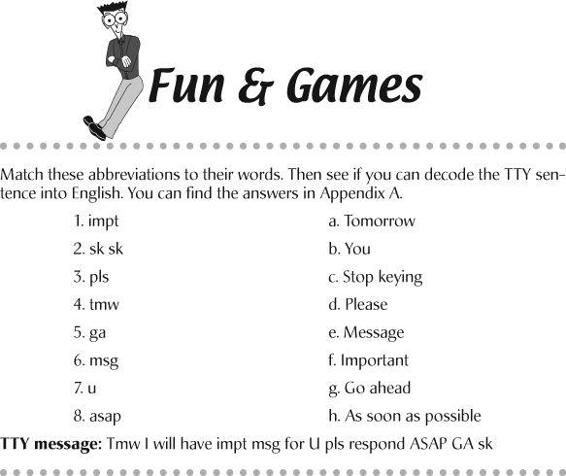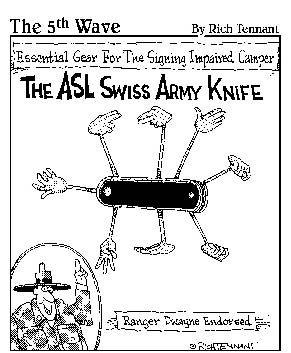Signing For Dummies (63 page)
Read Signing For Dummies Online
Authors: Adan R. Penilla,Angela Lee Taylor

When you do connect with someone on the other end, be sensitive regarding the operator. Most of them are skilled typists, but you may have a tendency to speak faster than the operator can type. Try speaking in segments, listening to the operator’s keys. When you hear the typing stop, you know that you can continue speaking.
Speaking privately through a third party
The operators who work for relay services agree to keep the conversations that they hear confidential. We have heard rumors of operators sharing portions of conversations with third parties, but as far as we know, we’ve never had that experience.
If you have to discuss issues that you feel uncomfortable talking about with an operator who’s of the opposite sex, you can request to have an operator of your same sex relay the call — as long as one is available.
Understanding conversations with relay service
The last thing that you need to remember when talking through the relay is that some Deaf people write like they sign. As discussed in previous chapters, English and Sign often don’t share the same grammatical rules. The typist will repeat everything verbatim, regardless of who’s doing the typing. The typist will repeat exactly what the Deaf person types and then the operator will type exactly what the hearing person says. If you’re talking to a Deaf person on the phone, it may be to your advantage to first read through this book to understand the ways of Sign.
Packing Pagers
Another means of communication that has become popular among the Deaf community is the use of pagers. Unlike the hearing, who typically use pagers as a means of obtaining phone numbers with which to call people back, the Deaf community uses pagers to actually communicate back and forth. (This type of communication is similar to the text-messaging that’s available on modern cell phones.)
These special pagers, called
two-way pagers,
are a compact version of a regular pager and TTY. They come complete with keyboards, phone directories, e-mail, and scrolling features. You can send a message and get a reply as quickly as it takes someone to type and send it. These pagers can be purchased at most telecommunication organizations, and you can also find them on the Web. They are a bit on the expensive side — often a few hundred dollars — but activation is included in the price. You can also find rebuilt models, which are a little cheaper, but your best bet is to wait for a sale on new models. You might want to look for a good deal on the Internet. Just go to your favorite search engine and type in “Deaf Pagers”; you’ll find plenty of information.
Two-way pagers work in regional areas but not necessarily throughout the country.
Another type of pager allows the Deaf person to type a text message into his pager. A relay center from the pager provider will receive the text. They will then call the number per the Deaf person’s request and repeat verbatim what the Deaf person wishes to relay. Unfortunately, cell phones don’t work with these pager systems.
Using a Tele-Interpreter
Tele-interpreting isn’t as common as it used to be. However, not all Deaf people have immediate access to communication devices, and machines tend to break down every now and then. Tele-interpreting, which utilizes the help of Sign Language interpreters, will always be a backup alternative.
Understanding the role of sign language interpreters
A Sign Language interpreter is a person who conveys information from spoken English into
American Sign Language
(ASL) and vice versa.
Many interpreters test for competency certification. Part of the test is understanding and following the code of ethics of sign language interpreters. Confidentiality is the most important part of this code; if an interpreter reveals information that she’s learned while interpreting, a formal complaint can be filed with the organization that issues the certification, and that complaint will be investigated.
Most interpreters who are nationally certified have been issued certification from the
Registry of Interpreters for the Deaf
(RID). A certification of competency means that you have satisfied the minimum requirements that have been established. To contact RID, go to
www.rid.org
, to contact NAD, go to
www.nad.org
. Certified interpreters from both organizations carry wallet-sized cards of verification. Noncertified interpreters are usually working toward being certified.
Using an interpreter for telephone conversations
Interpreting a phone conversation for a Deaf person is usually done when a Deaf person needs to give or receive information. When the phone is dialed and someone responds, the interpreter signs to the Deaf person that someone has answered. The Deaf person says who he is and that he’s speaking through an interpreter. A delay always occurs while the Deaf person is signing and the interpreter is visually reading the signed information. This silence may seem a little awkward, but it’s necessary. When the Deaf person is finished, he indicates that the conversation has ended by saying good-bye to the other party.
Another way to tele-interpret is to use an earpiece that’s connected to the phone. These are used by Deaf people who have speech capabilities but need an interpreter to receive information. This process is usually done with a Deaf person and a hearing person. The interpreter listens to the conversation through the earpiece and then signs to the Deaf person what the other party is saying. Again, the Deaf person terminates the conversation when he’s ready. At no point is the interpreter to intervene with any opinion or advice. The conversation should take place without the interpreter being an active participant in the actual conversation.
Telephone interpreting can become a complicated process if the interpreter begins the process without any foreknowledge of what the Deaf person is trying to accomplish. Most Deaf people let the interpreter know the reason for the call. The Deaf person then dials the number, and the interpreter begins the process.
Part V: The Part of Tens
In this part . . .
T
he three chapters in this part give you helpful and fun ideas to aid you in your quest for using Sign to communicate. Try all the ideas; explore places that you’ve never been or even knew existed, such as Deaf camps and clubs. Have confidence; ask a lot of questions. You can even have a little fun practicing some of the more popular Deaf idioms on your friends.
Chapter 15: Ten Tips to Help You Sign like a Pro
In This Chapter
This chapter is all about providing you with ideas to practice and polish your signing skills. So if you’re reading this, you’re on the right track.
Watch Yourself and Others Sign
Watching yourself sign while standing in front of a mirror helps you to see what others see when you sign. Watching interpreters lets you see how they make facial expressions and how they use Signs in context. Watching others sign also gives you the opportunity to
read
how they sign. Try videotaping yourself signing and then play it back. You can be your own best critic.
Discover Multiple Signs for Communicating One Thing
One thing can be signed in many different ways. The more ways you know, the more versatile you’ll be. Practice signing the variety of ways to mean something. Even if the Sign doesn’t suit you, you just may see it again. For example, there are a variety of ways to sign
do.
Ask a person who’s been signing for a few years to show them to you.
Practice Your Signing
Practicing is the only way to get comfortable with signing. Practice whenever you’re walking, lying in bed, or on your coffee break. Everyone may think that you’re a lunatic, but we know the truth! The bottom line: To be a really good signer, signing has to become second nature.
Always Fingerspell a Name First
The Deaf community gives name Signs to people. These name Signs serve as identification. However, a person’s name must be established before you can use his or her name Sign or talk about that person. If you don’t fingerspell a person’s name first, you’ll only cause confusion as to whom you mean.
Adjust Your Eyes; Everyone’s Signing Is Different
Personalities tend to come out in Sign, just as they do in English. Some people talk fast and sign fast while others want to give you all the details. Just as no two people talk alike, no two Signers sign alike. By being open to the ways that different people sign, you can grow to understand the variety of Signing styles as easily as you can understand most English speakers in the United States.
Facial Expressions Are Like Vocal Inflections
Imagine talking without any high or low pitches — speaking only in a monotone — with few clues to emphasize your point. Your conversation would be boring and hard to understand. The same holds true when you’re signing. If you sign about someone being angry, look angry! If you want to convey your joy, you need to show that joy, and if something scary happened to you, look scared! As a general rule, the most clear facial expression is an authentic one. You’ll achieve this by practicing actual expressions: Put on a big smile for joy, frown when you want to show sadness or unhappiness, or frown and scrunch your eyebrows together to convey a feeling of anger.
Keep a Journal of Your Great Experiences
Keeping a journal of your adventures in Sign is a great tool. Writing down the signs and styles you’ve encountered, the time you understood without asking for a repeat, and the first time you could tell someone what others were signing are all noteworthy events. Jotting these things down gives you the perfect way to see your own progress — it should be a great encouragement to you!
Get Some Signing Space
Signing and talking affect where you sit or stand. Because signing is manual, give Signers a little room to converse. If you need privacy, go somewhere private to have your conversation. Make sure that you stand where bright light or the sun isn’t directly behind you because whoever is watching you sign will only see your silhouette — a big giveaway that you’re just a beginner.
Don’t Jump the Gun
Sometimes, when you’re watching someone sign, you may lose that person and not understand what is meant. Don’t lose heart. Let that person finish the thought; you may put it all together at the very end after all the information has been signed. Then, if you still don’t understand, just explain that you didn’t catch everything and let that person know what you did catch.
Watch the Face, Not the Hands
You can find most of what you need to know on a Signer’s face. A person’s face conveys the mood, pauses, any information that can be demonstrated through mouth shapes, and how the action is done (slowly, quickly, sloppily). If you focus on a Signer’s hands, you miss a lot of crucial information; instead, focus on the Signer’s face and shoulders. Use your peripheral vision to watch the hands. By doing this, you see the whole Signer, and you’re apt to better understand the conversation.



